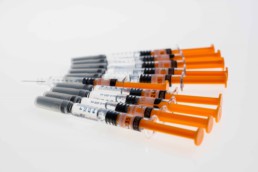What is in a flu shot? People get worried about what’s in a flu vaccine, but many studies over the years have shown that flu vaccines are safe. It is by far the best way to avoid having the flu and spreading it to other men and women. Influenza viruses are constantly changing, which means that the flu vaccine is updated each year.
However, these are the components that commonly comprise flu vaccines.
Influenza viruses
The flu vaccine includes tiny amounts of the viruses it protects from. The presence of the viruses from the vaccine triggers the body’s natural defence mechanism to produce antibodies to fight them. This means that the body quickly recognizes them when actually invaded by the virus.
Formaldehyde
Admittedly, formaldehyde is toxic and potentially deadly in high doses. But, it is present in such tiny amounts in an influenza vaccination that it is completely benign.
Formaldehyde’s function in the flu shot is to inactivate toxins out of viruses and bacteria that may contaminate the vaccine through creation, in addition to the viruses naturally present in the vaccine.
Formaldehyde is typically present in the human body also, and is a product of healthy digestive function.
Aluminum Salts
Aluminum has been used in vaccines for over 70 years. Aluminum salts are adjuvants, meaning they assist the body to come up with a stronger immune response against the virus in the vaccine. Because they improve the body’s response, this usually means that the vaccine can contain smaller amounts of the virus.
Comparable to formaldehyde, and to many ingredients in the flu shot, the quantity of aluminum within the vaccine is extremely tiny.
This chemical isn’t necessarily present in flu vaccines though. There are a few of which are aluminum-free.
Thimerosal
Thimerosal is not found in all flu vaccines. To describe exactly, thimerosal is a preservative that retains the vaccine free of contamination by fungi and bacteria. Without this, the growth of bacteria and fungi is common when a syringe has a multi-dose vial (a vial that contains over one dose).
Thimerosal is made from a natural form of mercury called ethylmercury, a secure compound that usually only remains in the bloodstream for a couple of days.
It is different from the typical mercury which can cause disease in massive doses, and from the type found in fish (known as methylmercury), which can remain in the body for years.
Flu shots will only include thimerosal when they’re in a multi-dose vial. Single-dose vials, pre-filled syringes, and sinus sprays do not need to incorporate this preservative since contamination is not a problem.
Chicken egg proteins
Proteins from chicken eggs help viruses to grow until they move into the vaccine.
Influenza viruses used in vaccines are usually grown inside fertilized chicken eggs, where the virus creates copies of itself. Following that, the germs are separated out of the egg and placed in the vaccine; this usually means that the final vaccine may contain small quantities of egg proteins.
It is also usually safe for people with egg allergies, but those who have an egg allergy must mention it to the doctor before receiving the shot. Someone with a severe egg allergy might require monitoring by a physician after the injection.
Of course, egg-free flu shots are also available.
Gelatin
Gelatin is used in the flu shot as a stabilizer. Stabilizers keep the vaccine effective from manufacturing until it is used..
Stabilizers also help to protect the vaccine from the harmful effects of heat or freeze-drying. Most influenza vaccines use pork-based gelatin as a stabilizer.
Antibiotics
Antibiotics are present in the flu vaccine to help keep bacteria from growing during the manufacturing and storage of the vaccine.
Vaccines do not include antibiotics that might lead to severe reactions, such as penicillin. Instead, vaccines include other forms of antibiotics, such as gentamicin or neomycin. Neomycin is also an ingredient in many topical medicines, like lotions, lotions, and eye drops.
All in all, the above are the common ingredients in a vaccine. As we’ve stated, these ingredients are very much benign, and though some may be harmful in large doses, those ingredients in very very tiny amounts that they don’t pose any threat at all. However, it is always a good idea to consult your physician if you feel that you could have any allergic reactions or concerns.
